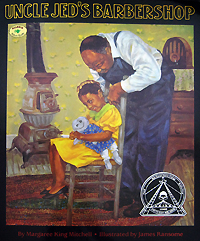|
|
|
|
|
|
|

| 최근 이 책을 구매하신 다른 회원의 책장 |
|
 |
|
|
|
[ 책 소개 ]
* Coretta Scott King Award 수상도서
* ALA Notable Children's Books
* CBC/NCSS Notable Children's Book in Social Studies
* Horn Book Fanfare
* IRA Children's Book Award Honor
오랜 세월 이발사로 살아 온 삼촌에 대한 회상. 인종 차별과 대공황기의 어려움을 극복하고 지역에서 유일하게 흑인이 운영하는 이발소의 문을 열게 된 제드 삼촌의 이야기를 사실적이고 아름다운 세밀화 그림으로 보여줍니다.
[ 관련 동영상 보기 ]
 ▶
[ 서지 정보 ]
Paperback: 40 pages
ISBN-10: 0689819137
ISBN-13: 978-0689819131
책 크기: 27.8 cm x 22.8 cm
[ 영문 서평 ]
Book Description
Sarah Jean's Uncle Jed was the only black barber in the county. He had a kind heart and a warm smile. And he had a dream. Living in the segregated South of the 1920's, where most people were sharecroppers. Uncle Jed had to travel all over the county to cut his customers' hair. He lived for the day when he could open his very own barbershop. But it was a long time, and many setbacks, from five-year-old Sarah Jean's emergency operation to the bank failures of the Great Depression, before the joyful day when Uncle Jed opened his shiny new shop -- and twirled a now grown-up Sarah Jean around in the barber chair. With James Ransome's richly colored paintings brimming with life, this is a stirring story of dreams long deferred and
Publishers Weekly
At age 79, Uncle Jed, after a lifetime of obstacles (including segregation and the Great Depression), finally realizes his dream of owning a barbershop. "Convivial descriptions of family life are enhanced by Ransome's spirited oil paintings," said PW. Ages 4-7.
School Library Journal
Uncle Jed, a black, itinerant barber in the pre-Depression South, dreams of opening his own shop. He saves for years, but first his niece, who narrates the story, needs an operation, and then the bank in which his money is kept fails. The man's spirit never flags, however, and he finally starts his own business at age 79. Sarah Jean, whose life was saved by her uncle's generosity, is by this time a middle-aged adult, and shares in his pleasure. Mitchell's text is eloquent in its simplicity. Straightforward, declarative sentences explain such concepts as segregation and sharecropping without emotional overtones, while her subdued prose makes readers keenly aware of the injustice of segregation. Through Sarah Jean's eyes, readers see both the poverty and discrimination endured and the sense of community and caring shared by her family and friends. Ransome's richly textured oil paintings, uncluttered and direct, beautifully complement the text. These are strong characters captured with forceful brush strokes, yet the illustrations also include such details as a crocheted saddle blanket. Both touching and inspirational, this book is ideal for story hours featuring favorite relatives, and it could start children saving for their own dreams.
|
|
|
|
|
|
|
|
|